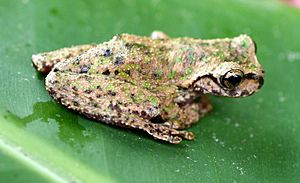Guatemala spikethumb frog facts for kids
Quick facts for kids Guatemala spikethumb frog |
|
|---|---|
 |
|
| Conservation status | |
| Scientific classification | |
| Synonyms | |
|
Hyla guatemalensis (Brocchi, 1877) |
The Guatemala spikethumb frog (scientific name: Plectrohyla guatemalensis) is a type of frog that lives in the cloud forests and mountains of Central America. You can find it in places like Mexico, Guatemala, El Salvador, and Honduras. It's known for a special "spike" on its thumb, which is why it's called a "spikethumb" frog! Scientists are still studying this frog, and they think there might even be more than one species hiding under this name.
Contents
What Does the Spikethumb Frog Look Like?
These frogs are medium-sized. Male frogs are about 4 to 5.2 centimeters (1.6 to 2 inches) long. Female frogs are a bit bigger, measuring about 4.2 to 5.4 centimeters (1.7 to 2.1 inches) long.
Their bodies are quite strong. Their head is about as wide as their body. They have a short snout and large eyes. A thick fold of skin covers part of their eardrum.
The color of their back can be different. Some are dark green, sometimes with reddish-brown spots. Others are reddish-brown, sometimes with dark brown spots or green flecks. The male frogs have a very large, two-part "spike" on their thumb. This is where their common name comes from!
Where Does This Frog Live?
The Guatemala spikethumb frog lives in cloud forests and other mountain forests. These forests are found at high places, from about 900 to 2,800 meters (2,950 to 9,200 feet) above sea level.
These frogs love mountain streams with flowing water. This is where they go to lay their eggs. During the day, you might find them hiding in plants called bromeliads or in cracks along stream banks. At night, they can be seen on tree branches hanging over streams or on rocks in the water.
How Do They Reproduce?
Male frogs often make calls from inside rocky cracks in the streams. They do this to attract female frogs. The females then lay their eggs in these streams, and the male fertilizes them.
Why Is This Frog in Danger?
The Guatemala spikethumb frog used to be common in El Salvador, Guatemala, and Honduras. Now, it's mostly common only in Honduras. It hasn't been seen in Mexico since 1944, even though people have searched for it.
The number of these frogs has gone down a lot in recent years. A big reason for this is a frog disease called chytridiomycosis. This disease affects many frogs around the world. Another major threat is habitat loss. This means their forest homes are being destroyed.
Good news is that these frogs live in several protected areas. These areas help keep their homes safe.
See also
 In Spanish: Plectrohyla guatemalensis para niños
In Spanish: Plectrohyla guatemalensis para niños


